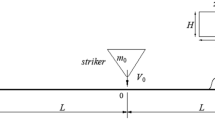Abstract
In this paper, a method of stress analysis is proposed to analyze impulsive stresses at an impact loading point, since use of the classical plate theory cannot lead to a convergent result. In particular, under these impact conditions (regardless of mass of impactor, velocity of impactor, stiffness of plate, etc.), we used the three-dimensional dynamic theory of elasticity and potential theory of displacement to analyze the impulsive strains at an impact loading point. Also, by using Hertzian contact theory to account for local deformation, the impact loading could be analyzed, and this loading was applied to the impulsive stress analysis by allowing the impact loading to be approximated to an analyzable function. In the numerical analysis, we used a fast Fourier transform (FFT) algorithm and applied the numerical inverse Laplace transformation.
Similar content being viewed by others
References
Wang, X. andYew, C.H., “Hypervelocity Impact of Two Spheres,”Int. J. Impact Eng.,8 (3),229–240 (1989).
Holian, K.S., “Hydrodynamics Code Calculation of Debris Clouds Produced by Ball-plate Impacts,”Int. J. Impact Eng.,10,231–239 (1990).
Chao, C.C. andTung, T.P., “Step Pressure and Blast Response of Clamped Orthotropic Hemispherical Shells,”Int. J. Impact Eng.,8 (3),191–207 (1989).
Kishimoto, K., Aoki, S. andSakata, M., “Simple Formula for Dynamic Stress Intensity Factor of Precracked Charpy Specimen,”Eng. Fract. Mech.,13,501 (1980).
Timoshenko, S.P. andWinowsky, K.S., Theory of Plates and Shells, McGraw-Hill, New York, 69 (1959).
Ugurad, A.C., Stress in Plate and Shells, McGraw-Hill, New York, 38 (1981).
Ujihashi, S.Y., “Impact Response Analysis of Beam by High-order Approximate Equation,”JSME(A),49 (448),152–153 (1983).
Ujihashi, S.Y., Adachi, T.H., Inoue, H.T. andMatsumoto, H.Y., “An Analytical and Experimental Study of Impulsive Stresses in a Glass Plate Subjected to the Transverse Impact of Steel Balls,”JSME(A),52 (474),505–531 (1986).
Yang, I.Y., “An Analytical Study of Impulsive Stresses in a Square Plate Subjected to a Concentrated Impact Using the Three-dimensional Dynamic Theory of Elasticity,” PhD thesis, Chonnam National University, 5–18 (1988).
Johnson, W., Impact Strength of Materials, Edward Arnold, London, 106 (1972).
Ni, H.-S., Theory of Modem Elasticity, OMU, Tokyo, 26–34 (1985).
Nakahara, I., Theory of Applied Elasticity, Jitsu-Kyu, Tokyo, 207 (1977).
Achenbach, J.D., Wave Propagation in Elastic Solids, North-Holland, New York, 67, (1975).
Timoshenko, S.P. andGere, J.M., “Theory of Elastic Stability,”McGraw-Hill, New York, 1–370 (1961).
Goldsmith, W., Impact, Edward Arnold, London, 83 (1960).
Zukas, J.A., Nicholas, T., et al., Impact Dynamics, John Wiley, New York, 57 (1976).
Krings, W. andWaller, H., “Contribution to the Numerical Treatment of Partial Differential Equations with the Laplace Transformation—An Application of the Algorithm of the Fast Laplace Transformation,”Int. J. for Numerical Method in Eng.,14,1186 (1979).
Author information
Authors and Affiliations
Rights and permissions
About this article
Cite this article
Yang, I.Y., Im, K.H. Impulsive stress analysis of plates at the concentrated impact loading point by the three-dimensional dynamic theory of elasticity. Experimental Mechanics 36, 421–429 (1996). https://doi.org/10.1007/BF02328587
Received:
Revised:
Issue Date:
DOI: https://doi.org/10.1007/BF02328587



